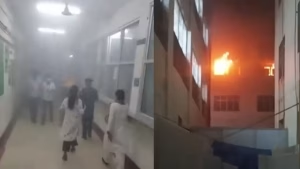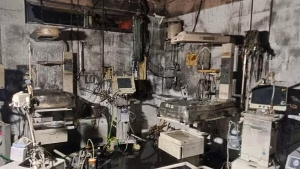Lucknow, Uttar Pradesh – In a dramatic turn of events, a Lucknow hospital fire broke out at a government-run facility, forcing an emergency evacuation of over 200 patients. The incident, which occurred during the early hours, prompted swift action by hospital authorities, fire services, and law enforcement. Thanks to the timely response, no injuries were reported, and the situation was brought under control.
The Lucknow hospital fire has sparked renewed conversations around fire safety standards in medical facilities across the state. Officials confirmed that the fire broke out in a section of the hospital used primarily for administrative storage and backup utilities, leading to the rapid spread of smoke. The cause of the blaze is still under investigation, but early signs suggest an electrical short circuit could be responsible.

This article provides a comprehensive overview of the Lucknow hospital fire, detailing the emergency response, evacuation procedures, impact on patient care, and the future of fire safety in public healthcare institutions.
Fire Breaks Out in Government Hospital: Timeline of the Incident
The Lucknow hospital fire erupted in the early morning hours, at a time when most of the hospital staff and patients were in a state of rest. According to officials, the fire originated from the second floor, which houses electrical equipment and records storage.
Hospital staff detected smoke emanating from the section around 3:45 AM and immediately raised the alarm. Emergency protocols were activated, and within minutes, fire brigade units were dispatched to the scene. As flames intensified, power supply was shut off in the affected block to prevent further escalation.
The Lucknow hospital fire was reported to the nearest fire station at approximately 3:52 AM. Firefighters arrived on the scene within 10 minutes, deploying four fire engines and additional water tankers. Their priority was to contain the fire and assist hospital authorities in evacuating vulnerable patients.
Heroic Evacuation of Over 200 Patients: A Test of Emergency Readiness
As the Lucknow hospital fire grew in intensity, medical staff, security personnel, and emergency response teams swung into action to evacuate the patients. Priority was given to ICU wards, neonatal units, and those on ventilator support.
Hospital corridors were cleared, elevators deactivated for safety, and evacuation was carried out through designated fire exits. Several patients were moved on stretchers and wheelchairs, while others were guided through the stairways with assistance from staff and volunteers.
Emergency medical teams set up triage zones outside the building to assess any distress among the patients. Ambulances were also stationed to transport critical patients to nearby hospitals if needed. Fortunately, all patients were accounted for, and no major injuries were reported as a result of the Lucknow hospital fire.
Deputy Chief Minister Responds: No Injuries, Situation Under Control


Following the Lucknow hospital fire, the Deputy Chief Minister, Brajesh Pathak arrived at the hospital site to assess the situation. In a public statement, he confirmed that no casualties or serious injuries occurred and praised the quick response of the fire services and hospital administration.
“The situation has been brought under control. All patients have been safely evacuated. There was no loss of life or critical injury, which is a testament to the coordination among teams during the emergency,” he stated.
His acknowledgment highlighted the effectiveness of the hospital’s emergency response system, despite the massive scale of the Lucknow hospital fire.
Initial Investigations Point to Electrical Short Circuit
While the official cause of the Lucknow hospital fire is still under review, preliminary inspections by the fire department suggest that an electrical short circuit could be the likely culprit. The affected area contained backup power systems, air conditioning units, and high-voltage cables.
Experts believe a fault in the circuit breaker or overheating of wires may have triggered the blaze. The combination of flammable paper records and wooden storage units likely accelerated the spread of the fire.
A technical team has been tasked with inspecting all hospital buildings for potential electrical hazards to prevent future incidents similar to the Lucknow hospital fire.
Fire Department’s Role: Rapid Action Saves Lives
The fire brigade’s quick arrival and coordinated strategy played a critical role in containing the Lucknow hospital fire. Firefighters used foam extinguishers, high-pressure water hoses, and breathing apparatus to enter smoke-filled corridors.
Their first task was to control the fire’s vertical and lateral spread to other hospital wings, especially wards containing patients. Firefighters also helped dismantle portions of the false ceiling and ventilated enclosed spaces to clear trapped smoke.
One firefighter sustained minor injuries during the operation but was immediately treated on-site. The successful containment ensured that the Lucknow hospital fire did not result in structural damage to the main hospital wards.
Impact on Patient Services and Hospital Operations

The Lucknow hospital fire temporarily disrupted hospital operations. Non-critical procedures and elective surgeries scheduled for the day were postponed. Emergency services, however, continued in a different wing of the hospital.
Hospital administration transferred some patients to nearby government and private hospitals as a precautionary measure. Medical records lost in the fire are being recovered through digital backups maintained in the hospital’s IT system.
Also Read: Bihar NDA Alliance Breaks: RLJP Exits Coalition in Explosive Move Amid Bihar Elections 2025
The hospital’s director announced that all essential services were restored within 12 hours of the incident, and patients were gradually being brought back to their respective wards.
Voices from the Ground: Staff and Patient Reactions
Many hospital staff members shared their experiences during the Lucknow hospital fire, praising the team spirit and training that helped them act swiftly. One nurse recounted how they helped a group of elderly patients out of a smoke-filled corridor with only a flashlight and damp cloths.
Family members of patients expressed relief that their loved ones were safe. “When I saw the news, I rushed to the hospital fearing the worst. But the management handled everything with calm and professionalism,” said a relative of a patient admitted to the cardiac ward.
Despite the trauma of the Lucknow hospital fire, the collective response from healthcare professionals and emergency workers instilled confidence in the city’s ability to manage large-scale hospital emergencies.
Public Health Officials Launch State-Wide Fire Safety Audit
In the wake of the Lucknow hospital fire, health authorities have initiated a comprehensive fire safety audit across all government-run hospitals in the state. The audit will assess:
-
Electrical load and wiring safety
-
Fire extinguisher placements and expiry
-
Functional smoke detectors and alarms
-
Clear evacuation routes and signage
-
Staff training in fire safety protocols
The state’s health secretary emphasized that no compromise would be made on safety standards. Hospitals found in violation of fire codes will be given deadlines to rectify the issues or face penalties.
This audit is expected to be completed within 60 days, marking a proactive step toward preventing future disasters like the Lucknow hospital fire.
Role of Technology in Managing the Crisis
Technology played a crucial role during the Lucknow hospital fire, particularly in three key areas:
-
Fire Detection: The hospital’s smoke detection system helped alert staff before the fire spread to patient areas.
-
Digital Records: Although paper files were damaged, patient data remained intact due to secure digital backups.
-
Real-Time Communication: Internal messaging apps allowed staff and responders to coordinate across departments.
Experts are now recommending that hospitals install AI-driven fire detection systems, capable of sending real-time alerts to the nearest fire station, to further reduce response time in incidents like the Lucknow hospital fire.
Government Announces Upgrades to Hospital Infrastructure
In response to the Lucknow hospital fire, the state government has pledged to invest in the modernization of public healthcare infrastructure. Immediate funding has been allocated for:
-
Upgrading fire-resistant building materials
-
Installing intelligent smoke and gas detectors
-
Reinforcing emergency staircases and fire exits
-
Comprehensive fire drills for all hospital employees
This commitment marks a significant policy shift aimed at reducing the vulnerability of hospitals to fires and other emergencies. The Lucknow hospital fire will serve as a case study for implementing new standards across the nation.
Medical Associations Demand Accountability and Safety Reforms
Medical associations and healthcare worker unions have responded to the Lucknow hospital fire by demanding stronger oversight and accountability. They have submitted proposals to the health ministry, which include:
-
Annual third-party safety inspections
-
Fire safety certifications before license renewals
-
Mandatory fire drills every quarter
-
Installation of automatic sprinkler systems in all wards
The professional community believes that such measures are essential to prevent tragic incidents in the future, especially in densely populated and high-risk areas like hospitals.
What Went Right: Lessons from the Lucknow Hospital Fire
While the Lucknow hospital fire was a major emergency, the outcome demonstrated several best practices:
-
Preparedness: Regular fire drills ensured staff knew evacuation protocols.
-
Communication: Prompt alerts helped coordinate a city-wide response.
-
Resilience: Backup systems allowed essential services to resume quickly.
-
Teamwork: Medical and fire personnel worked seamlessly to protect lives.
These factors turned what could have been a tragic event into a well-managed crisis response. Other institutions are now studying the incident to implement similar safety protocols.
Conclusion: The Aftermath and the Way Forward
The Lucknow hospital fire serves as a stark reminder of the challenges hospitals face in maintaining safety amid infrastructural and operational complexities. While no lives were lost, the incident has sparked a state-wide push for improved fire safety in medical institutions.
From emergency evacuations to government policy reform, the Lucknow hospital fire has reshaped the way public health facilities approach crisis management. It highlighted the importance of preparedness, coordination, and quick decision-making in saving lives.
As fire safety audits proceed and new technologies are implemented, it is hoped that the lessons learned from the Lucknow hospital fire will lead to long-term improvements across India’s healthcare infrastructure.

